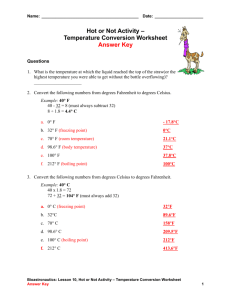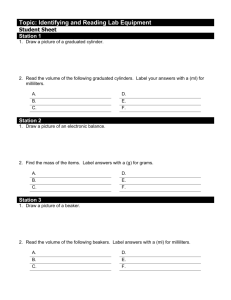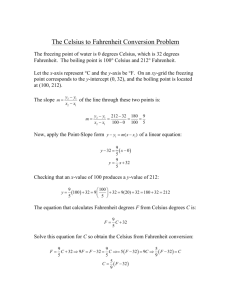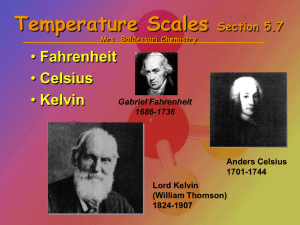Temperature Conversions Worksheet
advertisement
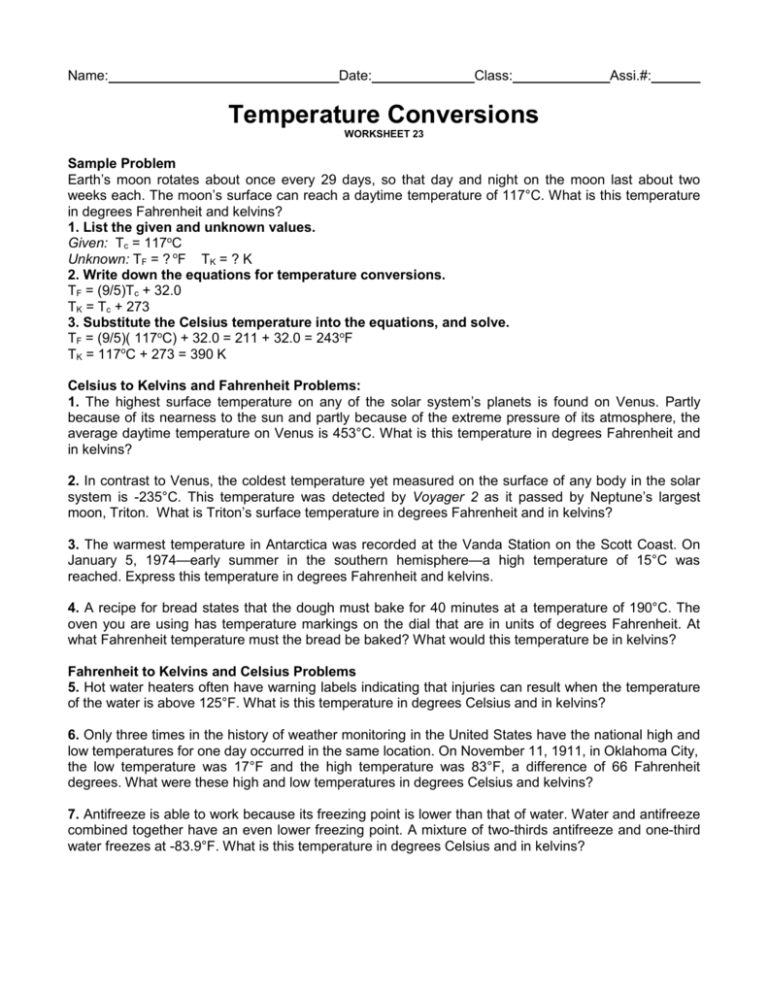
Name: Date: Class: Assi.#: Temperature Conversions WORKSHEET 23 Sample Problem Earth’s moon rotates about once every 29 days, so that day and night on the moon last about two weeks each. The moon’s surface can reach a daytime temperature of 117°C. What is this temperature in degrees Fahrenheit and kelvins? 1. List the given and unknown values. Given: Tc = 117oC Unknown: TF = ? oF TK = ? K 2. Write down the equations for temperature conversions. TF = (9/5)Tc + 32.0 TK = Tc + 273 3. Substitute the Celsius temperature into the equations, and solve. TF = (9/5)( 117oC) + 32.0 = 211 + 32.0 = 243oF TK = 117oC + 273 = 390 K Celsius to Kelvins and Fahrenheit Problems: 1. The highest surface temperature on any of the solar system’s planets is found on Venus. Partly because of its nearness to the sun and partly because of the extreme pressure of its atmosphere, the average daytime temperature on Venus is 453°C. What is this temperature in degrees Fahrenheit and in kelvins? 2. In contrast to Venus, the coldest temperature yet measured on the surface of any body in the solar system is -235°C. This temperature was detected by Voyager 2 as it passed by Neptune’s largest moon, Triton. What is Triton’s surface temperature in degrees Fahrenheit and in kelvins? 3. The warmest temperature in Antarctica was recorded at the Vanda Station on the Scott Coast. On January 5, 1974—early summer in the southern hemisphere—a high temperature of 15°C was reached. Express this temperature in degrees Fahrenheit and kelvins. 4. A recipe for bread states that the dough must bake for 40 minutes at a temperature of 190°C. The oven you are using has temperature markings on the dial that are in units of degrees Fahrenheit. At what Fahrenheit temperature must the bread be baked? What would this temperature be in kelvins? Fahrenheit to Kelvins and Celsius Problems 5. Hot water heaters often have warning labels indicating that injuries can result when the temperature of the water is above 125°F. What is this temperature in degrees Celsius and in kelvins? 6. Only three times in the history of weather monitoring in the United States have the national high and low temperatures for one day occurred in the same location. On November 11, 1911, in Oklahoma City, the low temperature was 17°F and the high temperature was 83°F, a difference of 66 Fahrenheit degrees. What were these high and low temperatures in degrees Celsius and kelvins? 7. Antifreeze is able to work because its freezing point is lower than that of water. Water and antifreeze combined together have an even lower freezing point. A mixture of two-thirds antifreeze and one-third water freezes at -83.9°F. What is this temperature in degrees Celsius and in kelvins? 8. Most antifreezes also serve as engine coolants, because their boiling points are higher than that of water. Water and antifreeze combined together have an even higher boiling point. A mixture of twothirds antifreeze/coolant and one-third water boils at 276°F. What is this temperature in degrees Celsius and in kelvins? Kelvins to Celsius and Fahrenheit Problems 9. The temperature at Earth’s center is estimated to be about 5100 K. Express this temperature in both degrees Celsius and degrees Fahrenheit. 10. One of the most deadly features of an erupting volcano is an avalanche of hot ash and gas called a pyroclastic flow. A pyroclastic flow can move at a speed of over 160 km/h and can have a temperature of 1088 K. What is this temperature in degrees Fahrenheit and degrees Celsius? 11. The coolest part of the sun is the region called the chromosphere, which is the region above the sun’s apparent surface, or photosphere. At 1100 km above the photosphere, the temperature of the chromosphere is about 3500 K. What is this temperature in degrees Fahrenheit and degrees Celsius? 12. The highest temperature that the atmosphere of Mars reaches is about 240 K. What is this temperature in degrees Fahrenheit and degrees Celsius? Mixed Review 13. One of the most dramatic temperature changes over a short distance occurs in Ecuador. The average temperature at the town of Ventanas, which is at 100 m above sea level, is 29°C. Some 70 km to the east is the extinct volcano, Volcán Chimborazo, the summit of which is 6270 m above sea level. The temperature at the summit is -11°C, in spite of the mountain being only about 170 km south of the Equator. Express both temperatures in degrees Fahrenheit. 14. The sun’s temperature decreases steadily as the distance from its innermost regions increases. The sole exception to this is in the outermost part of the sun’s atmosphere. This region, called the corona, consists of thin gases that are heated by the sun’s magnetic field. As a result, the corona has an average temperature of about K. What is this temperature in degrees Celsius? 15. Liquid helium has the lowest boiling point of any liquid at atmospheric pressure. Helium remains in the gaseous state until its temperature is lowered to 4.25 K, at which point it condenses into a liquid state. Express the boiling point of liquid helium in degrees Fahrenheit. 16. The electric heating element on a stove uses electricity to raise its temperature. A typical heating element can reach a temperature of about 4200°C. Express this temperature in kelvins. 18. Hypothermia is a condition in which the body gives up too much energy by heat to its colder surroundings. For humans, a drop in body temperature to 90.0°F can cause unconsciousness, and a temperature of 78°F can be fatal. a. Express these temperatures in degrees Celsius. b. In one recent case, a young girl was accidentally locked out of her home during winter. When she was discovered, her body temperature had fallen to 14°C. Fortunately, she survived and recovered fully. What was her body temperature in degrees Fahrenheit? How much lower is this temperature than the normal fatal temperature for hypothermia? 19. Just as the human body cannot survive if its temperature falls to too low a temperature, it also cannot survive if its temperature is too high. In a condition called hyperthermia, energy is transferred to the body from its surroundings, causing the body’s temperature to increase. The condition known as heat stroke is a severe form of hyperthermia. Normally, a person cannot survive for long at a temperature of about 42°C, although a recent survivor of heat stroke had a high temperature of nearly 47°C. Express both of these temperatures in degrees Fahrenheit.
